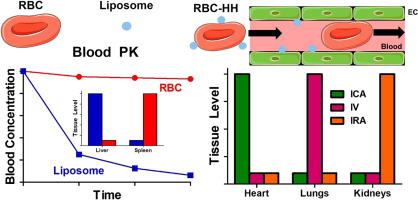Advanced Drug Delivery Reviews ( IF 16.1 ) Pub Date : 2021-09-29 , DOI: 10.1016/j.addr.2021.113992 Patrick M Glassman 1 , Elizabeth D Hood 1 , Laura T Ferguson 2 , Zongmin Zhao 3 , Don L Siegel 4 , Samir Mitragotri 5 , Jacob S Brenner 2 , Vladimir R Muzykantov 1

|
Drug delivery research pursues many types of carriers including proteins and other macromolecules, natural and synthetic polymeric structures, nanocarriers of diverse compositions and cells. In particular, liposomes and lipid nanoparticles represent arguably the most advanced and popular human-made nanocarriers, already in multiple clinical applications. On the other hand, red blood cells (RBCs) represent attractive natural carriers for the vascular route, featuring at least two distinct compartments for loading pharmacological cargoes, namely inner space enclosed by the plasma membrane and the outer surface of this membrane. Historically, studies of liposomal drug delivery systems (DDS) astronomically outnumbered and surpassed the RBC-based DDS. Nevertheless, these two types of carriers have different profile of advantages and disadvantages. Recent studies showed that RBC-based drug carriers indeed may feature unique pharmacokinetic and biodistribution characteristics favorably changing benefit/risk ratio of some cargo agents. Furthermore, RBC carriage cardinally alters behavior and effect of nanocarriers in the bloodstream, so called RBC hitchhiking (RBC-HH). This article represents an attempt for the comparative analysis of liposomal vs RBC drug delivery, culminating with design of hybrid DDSs enabling mutual collaborative advantages such as RBC-HH and camouflaging nanoparticles by RBC membrane. Finally, we discuss the key current challenges faced by these and other RBC-based DDSs including the issue of potential unintended and adverse effect and contingency measures to ameliorate this and other concerns.
中文翻译:

红细胞:被忽视的载体变身为人造纳米载体的天然母舰
药物输送研究追求多种类型的载体,包括蛋白质和其他大分子、天然和合成的聚合物结构、不同成分和细胞的纳米载体。特别是,脂质体和脂质纳米颗粒可以说代表了最先进和最流行的人造纳米载体,已经在多种临床应用中。另一方面,红细胞(RBC)代表了血管途径有吸引力的天然载体,具有至少两个用于装载药理学货物的不同隔室,即由质膜和该膜的外表面包围的内部空间。从历史上看,脂质体药物递送系统 (DDS) 的研究数量远远超过基于红细胞的 DDS。然而,这两种类型的载体具有不同的优点和缺点。最近的研究表明,基于红细胞的药物载体确实可能具有独特的药代动力学和生物分布特征,有利于改变某些货物制剂的效益/风险比。此外,红细胞运输从根本上改变了纳米载体在血液中的行为和作用,即所谓的红细胞搭便车(RBC-HH)。本文尝试对脂质体与红细胞药物递送进行比较分析,最终设计出能够实现相互协作优势的混合 DDS,例如 RBC-HH 和红细胞膜伪装纳米颗粒。最后,我们讨论了这些和其他基于 RBC 的 DDS 当前面临的主要挑战,包括潜在的意外和不利影响的问题以及缓解这一问题和其他问题的应急措施。



























 京公网安备 11010802027423号
京公网安备 11010802027423号